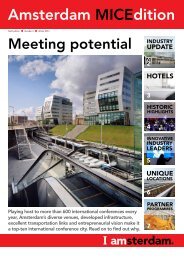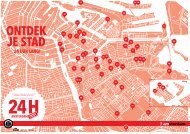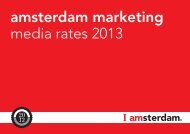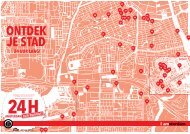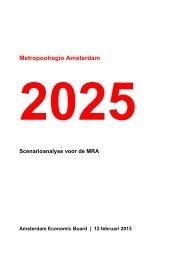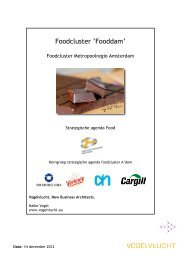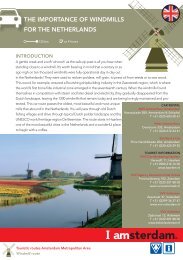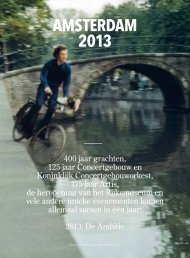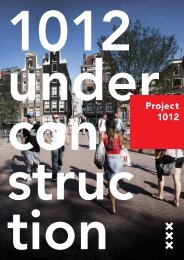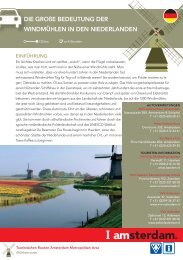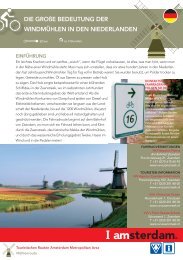citymarketing 5 - I amsterdam
citymarketing 5 - I amsterdam
citymarketing 5 - I amsterdam
Create successful ePaper yourself
Turn your PDF publications into a flip-book with our unique Google optimized e-Paper software.
Het is niet verwonderlijk dat het economische perspectief in<br />
deze city marketing-selectie domineert. De wereld is de afgelopen<br />
deennia ingrijpend veranderd en daarbij past een nieuw<br />
imago. Dit moet uiteindelijk wel rendement opleveren, zowel<br />
economisch als ook cultureel en sociaal. Amsterdam heeft veel<br />
baat gehad van haar reputatie als cultuurstad en bij de<br />
“quality of life”-aspecten, die internationaal vermaard zijn.<br />
Dit wil níet zeggen dat dit de enige groepen zijn die Amsterdam<br />
kent of die de voordelen ondervinden van het city<br />
marketingbeleid; het geeft echter wél richting aan de activiteiten:<br />
investeren we juist in deze doelgroepen, dan heeft<br />
heel Amsterdam en de omgeving er op de lange termijn iets<br />
aan. Samengevat: een creatieve kennisstad trekt direct en<br />
indirect werkgelegenheid aan. Indirecte werkgelegenheid<br />
ontstaat omdat bedrijven naar plaatsen trekken waar veel<br />
talent woont.<br />
Met de benoeming van de doelgroepen is het mogelijk om de<br />
doelstellingen van de Amsterdamse city marketing nader te<br />
specificeren. Alleen zo is gerichte actie mogelijk en alleen zo<br />
kun je de effectiviteit enigszins beoordelen. De specifieke doelstellingen<br />
per doelgroep zijn vanzelfsprekend gerelateerd aan<br />
de geformuleerde prioriteiten in dimensies en kernwaarden.<br />
2.3.1 Doelstellingen van city marketing<br />
City marketing is geen doel op zich, maar een middel.<br />
Amsterdam wil door middel van city marketing een onderscheidende<br />
relevante positie verwerven en behouden bij de<br />
geselecteerde doelgroepen, met als resultaat een stijging (of<br />
handhaving) van het bezoek of het gebruik van producten en<br />
diensten in Amsterdam en regio door deze doelgroepen.<br />
De investeringen in het merk Amsterdam moeten resultaten<br />
opleveren op het gebied van inkomsten, bezoekersaantallen,<br />
investeringen, marktpositie in de wereld, imago, enzovoort.<br />
Deze resultaten vormen samen de “return on the brand”.<br />
“Return on the brand” bestaat uit drie componenten, die<br />
elkaar onderling versterken:<br />
• Mentale positie (subjectief): de ontwikkeling van bekendheid<br />
van en voorkeur voor Amsterdam bij de geselecteerde<br />
doelgroepen;<br />
• Bezoek-, investerings- en koopgedrag (absoluut): de ontwikkeling<br />
van aantal bezoeken, aantal bedrijfsvestigingen,<br />
hoeveelheid bestedingen van de geselecteerde doelgroepen;<br />
• Marktpositie (relatief): de ontwikkeling van de positie (het<br />
marktaandeel) van Amsterdam op de relevante internationale<br />
lijstjes ten opzichte van de belangrijkste concurrenten.<br />
Om te kunnen vaststellen of city marketing bijdraagt aan<br />
versterking van de positie van Amsterdam zijn aan de zeven<br />
doelgroepen meetbare doelstellingen gekoppeld: doelstellingen<br />
op het gebied van spontane bekendheid en voorkeur<br />
(subjectief), daadwerkelijk bezoek-, investerings en koopgedrag<br />
(objectief) en internationaal marktaandeel (relatief).<br />
In onderstaande tabel wordt een weergave gegeven van de<br />
specificatie van doelstellingen per doelgroep, zoveel mogelijk<br />
gerelateerd aan reeds beschikbaar cijfermateriaal:<br />
I <strong>amsterdam</strong> Het ontstaan van de city marketing van Amsterdam 23<br />
It is not surprising that it is the economic perspective that<br />
dominates in this selection of city marketing target groups.<br />
The world has changed dramatically over the past years, and<br />
this calls for a new image. Eventually this must lead to<br />
returns, economic as well as cultural and social. Amsterdam<br />
has gained great benefit from its reputation as an internationally<br />
renowned cultural city and by its good ‘quality of life’<br />
aspects. That does not mean to say that these are the only<br />
groups who know Amsterdam or who see the benefits of a<br />
city marketing policy. However, it does give direction to the<br />
promotional activities: if we invest in just these target groups<br />
then in the long run it will be of benefit to the Amsterdam<br />
area.<br />
In summary, a creative knowledge city creates employment<br />
opportunities both directly and indirectly. Indirect opportunities<br />
are created because companies are attracted to locations<br />
in which many talented people live.<br />
Specifying these target groups makes it possible and necessary<br />
to specify further the objectives of Amsterdam city marketing.<br />
Only then will it be possible to focus actions and the<br />
effectiveness of the policy can only then be evaluated. The<br />
specific objectives for each target group are of course related<br />
to the formulated priorities in dimensions and core values.<br />
2.3.1 Objectives of city marketing<br />
City marketing is not an objective in itself but a means to an<br />
end. Amsterdam will be able to achieve and maintain a distinctive<br />
relevant position with the selected target groups<br />
because of city marketing. This will lead to an increase (or<br />
maintenance) of the number of visitors or the use of products<br />
and services in Amsterdam and surroundings by these target<br />
groups.<br />
Investing in the brand Amsterdam must produce results in the<br />
areas of income, visitor numbers, investments, market position<br />
in the world, image, etc. These results together form the<br />
‘return on the brand’, which consists of three components<br />
which mutually support each other:<br />
• Mental position (subjective): rise of familiarity with and<br />
preference for Amsterdam in the selected target groups;<br />
• Visitor, investment and purchasing behaviour (absolute):<br />
rise in the numbers of visitors, number of company investments,<br />
number of orders from the selected target groups;<br />
• Market position (relative): rise in the position (market<br />
share) of Amsterdam on the relevant international lists<br />
compared to its most important competitors.<br />
In order to establish whether city marketing contributes to<br />
strengthening the position of Amsterdam, measurable objectives<br />
were linked to the seven target groups: objectives in the<br />
area of spontaneous brand awareness and preference (subjective),<br />
actual visit, investment and purchasing behaviour (objective)<br />
and international market share (relative). The specifications<br />
for the objectives for each target group are given in the<br />
following table and are related as far as possible to data<br />
already available:



